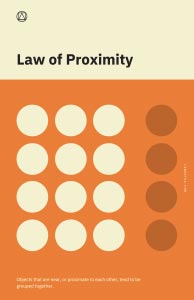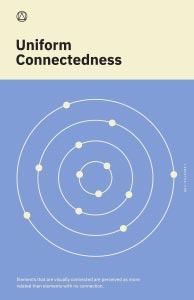Laws of UX Series: Law of Proximity, Law of Similarity and the Law of Uniform Connectedness.
Laws of UX are a collection of design heuristics created by Jon Yablonski to help designers leverage psychology to create more human-centered experiences. You can find explanations for each law on the website lawsofux.com, as well as an in-depth case study regarding his thought process on his website, jonyablonski.com
This will be a series of blog posts briefly covering the many laws and how they can help designers create better experiences for law firms.
 1) Law of Proximity
1) Law of Proximity
“Objects that are near, or proximate to each other, tend to be grouped together.”
The Law of Proximity defines how the human eyes with how our eye and brain form connections with visual elements. Elements that are close together are perceived as a group and related to each other. Elements that have space between them establish a disconnect and are not related.
For example, paragraphs in a book or blog post follow the Law of Proximity by grouping specific sections of text together to form similar ideas. Also, take our contact form in our footer for example. By placing the contact information and form fields within the boundary of a box, we have established that everything within that element is related to each other and focuses on one specific function.
 2) Law of Similarity
2) Law of Similarity
“The human eye tends to perceive similar elements in a design as a complete picture, shape, or group, even if those elements are separated.”
The Law of Similarity is similar (heh heh) to the Law of Proximity. While the Law of Proximity states that elements that are close together are perceived as a unified group, the Law of Similarity states that elements that are similar to each other are perceived as a unified group, even if they are not grouped together. Similarity can be defined as shape, color, size, orientation, etc.
 3) Law of Uniform Connectedness
3) Law of Uniform Connectedness
“Elements that are visually connected are perceived as more related than elements with no connection.”
The Law of Uniform Connectedness states that elements connected by uniform visual properties are perceived as a unified group more than elements that are not connected. Similar to the Law of Proximity, if a group of identical circles is enclosed in a box OR connected by a line, they are more closely related than the other circles that are outside of the box or not connected by a line.
Stay tuned for the next post in this series where I go over Miller’s Law, Peak-End Rule, and the Serial Position Effect.
